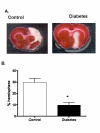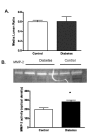Increased hemorrhagic transformation and altered infarct size and localization after experimental stroke in a rat model type 2 diabetes
- PMID: 17937795
- PMCID: PMC2098774
- DOI: 10.1186/1471-2377-7-33
Increased hemorrhagic transformation and altered infarct size and localization after experimental stroke in a rat model type 2 diabetes
Abstract
Background: Interruption of flow through of cerebral blood vessels results in acute ischemic stroke. Subsequent breakdown of the blood brain barrier increases cerebral injury by the development of vasogenic edema and secondary hemorrhage known as hemorrhagic transformation (HT). Diabetes is a risk factor for stroke as well as poor outcome of stroke. The current study tested the hypothesis that diabetes-induced changes in the cerebral vasculature increase the risk of HT and augment ischemic injury.
Methods: Diabetic Goto-Kakizaki (GK) or control rats underwent 3 hours of middle cerebral artery occlusion and 21 h reperfusion followed by evaluation of infarct size, hemorrhage and neurological outcome.
Results: Infarct size was significantly smaller in GK rats (10 +/- 2 vs 30 +/- 4%, p < 0.001). There was significantly more frequent hematoma formation in the ischemic hemisphere in GK rats as opposed to controls. Cerebrovascular tortuosity index was increased in the GK model (1.13 +/- 0.01 vs 1.34 +/- 0.06, P < 0.001) indicative of changes in vessel architecture.
Conclusion: These findings provide evidence that there is cerebrovascular remodeling in diabetes. While diabetes-induced remodeling appears to prevent infarct expansion, these changes in blood vessels increase the risk for HT possibly exacerbating neurovascular damage due to cerebral ischemia/reperfusion in diabetes.
Figures




References
-
- Cipolla MJ, McCall AL, Lessov N, Porter JM. Reperfusion decreases myogenic reactivity and alters middle cerebral artery function after focal cerebral ischemia in rats. Stroke. 1997;28:176–180. - PubMed
Publication types
MeSH terms
Substances
Grants and funding
LinkOut - more resources
Full Text Sources
Medical

